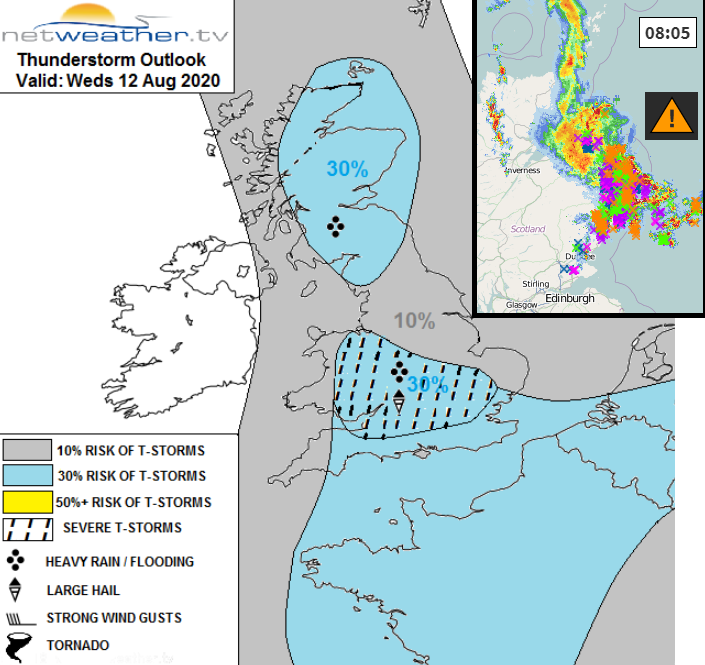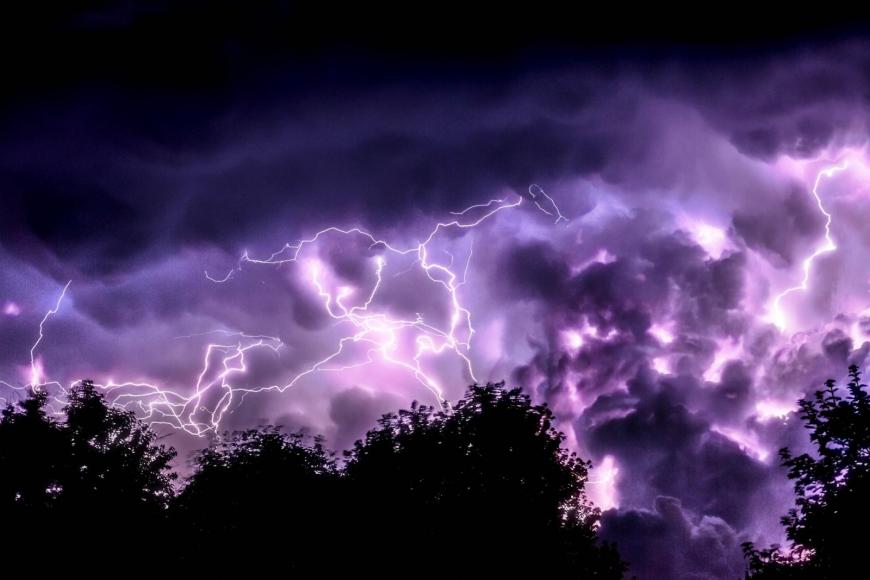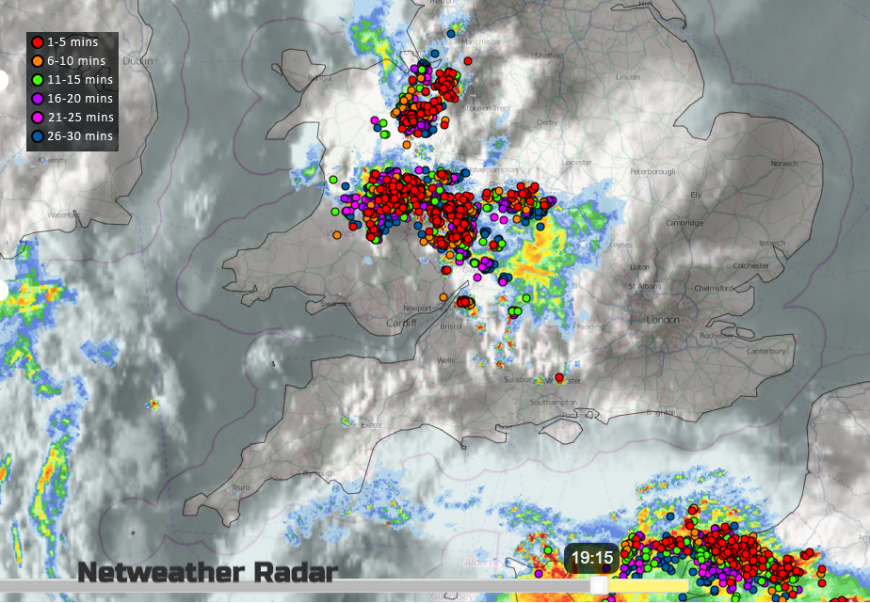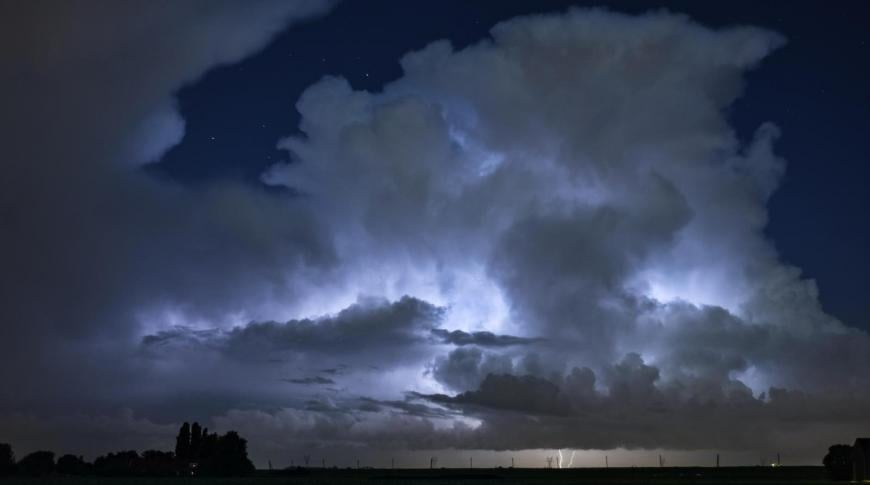
What is the best thing to do if you are caught in a thunderstorm? Outside or in, on land or water, up a hill or on the beach. The chance of lightning hitting any one spot is low in the UK and of hitting you, it's even lower. However, there are several things that you can do to reduce that risk further.
“the UK risk of being struck by lightning and experiencing an injury or death for the most recent 10-year period (2007-2016) is around one person in every 5 to 6 million people.” Elsom & Webb 2017
Lightning is a giant discharge of electricity, between the clouds or between the air and the ground. Thunder is the noise of the air that the charge passes through, being heated up very quickly and expanding. It is better to avoid being outside in a thunderstorm, even though being inside isn’t wholly safe either.
Basic steps:
Weather setups
Thunderstorms occur in unstable air where uplift takes place. Convective shower clouds grow into large, towering Cumulonimbus clouds. These are very distinctive and tall, although they can be hidden by other clouds that are closer to you. They often develop a tell-tale anvil top where ice crystals start to move outwards rather than upwards. A CB cloud will bring heavy rain, can produce hail and also lightning. For a thunderstorm, you need moist air near the ground, heat or warmth to allow the air to rise (the convection), and a trigger to set off the uplift or to break any capping layer. You can also see thunderstorms embedded on an active cold front.
Reliable weather forecasts will mention the risk of thunderstorms, thundery showers or lightning. If hail is in the forecast, then there could be lightning. However, as with all showers, one area can get a downpour, and a mile down the road, it stays dry. Same with thunderstorms, a risk area can be highlighted, say by a yellow warning from the Met Office or risk area on Netweather convective forecast, but the cells will be hit and miss in that area. Weather apps can struggle in showery setup ups, giving a line of thunderstorms or fluctuating hourly with timings of fine then very wet spells. It is about the risks of a downpour or thunderstorm, not certainty in timings or location.

Also, these are areas of most risk. That doesn’t mean that outside the area, there won’t be any thunderstorms at all. Forecasts change or get updated. If the forecast mentions thundery showers, just keep it in your mind. On the Netweather Radar, you can turn on the lightning strikes, the 'Sferics'. You can also follow the progress of thunderstorms using the animation to see which way they are moving. The 700hPa flow is often used as steering winds for large storms. An alert can also be set on the Radar app for rain or lightning in a certain radius. Handy when golfing or if your washing is out. Also, for camping overnight but it will only work whilst you have a signal. If heading out to the mountains or for a ramble, would a different day or route be better this time?
Severe thunderstorms can occur in the summer months. These bring torrential rain with a risk of flash flooding, large hail, sudden gusty winds and frequent lightning. For example, in the convective setup of early August 2020, when there were severe storms for several days within a UK heatwave. These resulted in hours of lightning, incredible displays by night but also devastating landslides.
 Photo by Jeremy Thomas on Unsplash
Photo by Jeremy Thomas on Unsplash
Outdoors
By counting in between the lightning flash and thunder rumble, you can estimate how far away the storm is. 1 elephant, 2 elephant etc., will give you the seconds, then divide by 5 to get the number of miles. So, 10 elephants /5 = 2 miles away.
This playground technique can enable you to decide if that storm is moving away or towards you. Of course, there may be another thunderstorm following it. Most (around 90%) of lightning moves from cloud to cloud (CC), so it doesn’t trouble us. Cloud to Ground (CG) strokes occur less often. Lightning injuries tend to happen as storms are beginning or are ending. In the midst of the action, people generally have taken shelter and are out of harm’s way. Looking at your clothesline outside and realising that your washing is already soaking means that leaving it there is actually a valid, safe choice. Being caught unawares by lightning “out of nowhere” or returning outside too quickly, before a storm has finished, is still a danger zone.
 August 12th 2020- Amber warned area over Wales and Midlands
August 12th 2020- Amber warned area over Wales and Midlands
Suppose you hear a rumble or see a lightning strike, you will need to assess how close the storm is. The 30/30 rule is used in some countries. Is the ‘flash to bang’ less than 30 seconds, or is it less than 30 mins since the last lightning strike? If yes to either, then the storm could be considered dangerously close. It is recommended that people don’t return to their activities until 30 minutes after the last lightning strike.
Getting indoors is best. Inside a car is fine too, although not a convertible. Unplug any hands-free attachments from your body, close the windows and avoid touching metal parts of the car. Don’t race off away from the storm; the visibility may well be poor, gusty winds could affect you or other road users and be aware of flooding. If lightning hasn’t already wrecked your electrics, then being submerged in floodwaters certainly will.
If getting inside is not an option, if you are out walking, try to get away from wide-open spaces or exposed hillsides. Come lower down off peaks and ridges. The lightning will look for the easier, quickest path to earth., Your height could aid that path.
Do not shelter under a tree. The lightning may start off moving down through the tree but then pass through you as an easier route. Also, tree bark or branches have a tendency to explode off when hit.

If you really are exposed or just feel that the storm is dangerously close, then you should crouch down. Feet together, hands on knees with head tucked in. This keeps most of you off the ground, protects your head which you really don’t want to be struck. Don't lie on the ground. You can sit on your rucksack with your knees drawn in towards you, it's about becoming small.
If you are carrying golf clubs, walking poles, or ice axe, move them away from you and your group. Also, leave some distance between people in your group. If lightning does come your way, there will be someone to assist and call for help. It’s also worth getting away from water, so from a lakeside, the beach or a stream. Another thing to bear in mind when choosing a low place such as a ravine or gully is that thunderstorms can bring torrential rain and so the risk of flash flooding.
It isn’t just the direct lightning strikes from above which can cause injury. Sometimes a partial strike can occur from a nearby object as it jumps sideways to a new path through you or as strike moves along the ground or through water. If you can’t get to shelter, then you will have to reduce the potential power of any strike by adjusting your stance but not lying down. Several cows were killed in a field in Co. Clare in June 2020 as lightning passed along the damp, boggy ground. Being near a metal fence is also dangerous. Having shoes on or a plastic mat under you is better than bare feet for ground current but makes no difference for direct strikes from above.
If stuck out surfing, crouch down in the middle of the board but try to get out of the water as soon as you can. Stop fishing. Don’t faff about with paddles, boards and watercraft; get to safety. Again, do not shelter beneath tall or isolated trees.
Does lightning strike twice? Yes, tall buildings have lightning conductors for this very reason to take the strike safely down to earth without damaging the church or skyscraper. The world record for a person being hit is seven. According to the Guinness Book of Records, Roy Sullivan, a Park Ranger in Virginia, has lost his big toenail, eyebrows and suffered burns and hair loss in the numerous strikes from 1942 to 1977. Working outdoors is more risky.
Indoors
Unplug stuff. If a thunderstorm starts up, unplug your television and ignore any moaning children. If your home computer or phone charging point doesn’t have a surge protector (really!), then unplug that too. Lightning can cause power surges with a hit more likely if you live up a hill. Landline telephones can also be affected as they conduct electricity. Ask my mother, she was electrocuted in her ear whilst chatting on the phone at the start of a storm, just before our television blew up. Ideally, don’t use the landline until after the storm has passed (except in an emergency). Equally, don’t stand outside on your mobile phone.
What to do if someone is hit by lightning.
Lightning can cause serious burns and also cause the heart to stop. A person may appear dead, but they can sometimes be revived. It is important to know that they will not still be “filled” with electricity. The strike will be grounded in the earth. However, the storm may be ongoing, and the first part of any First Aid, if you remember DR ABC, D is Danger. Is there an ongoing danger to you? They will need immediate help. Call for 999, if needed, begin CPR and move if necessary/suitable. CPR attempts to restore partial flow of oxygenated blood to the brain and heart, can you access a defibrillator? If someone is conscious, they may well be distressed and have hearing problems. The casualty will need monitoring, reassuring and to seek medical assistance. The worst thing would be for lightning to strike someone’s head which is why the crouching position with head tucked in is recommended. Alternatively, they may suffer minor burns, temporary weakness in a limb, or just experience a strange tingling.
All of that said, it is hugely unlikely that you will be struck by lightning here in the UK. It is not something to worry about in everyday life; just remember that extra care can be applied in some situations.
“In the UK in the past 30 years (1987-2016), 58 people were known to have been killed by lightning, that is, on average, two people per year. The average annual risk of being struck and killed was one person in 33 million. If only the past ten years are considered, a period with fewer average lightning deaths, the risk was one person in 71 million” Elsom and Webb 2017
The US National Weather Service advice is clear and simple - When thunder roars, go indoors!
Top photo by Photo by Max Saeling on Unsplash.
Loading recent activity...